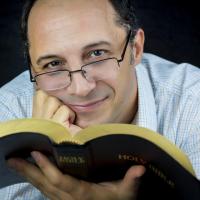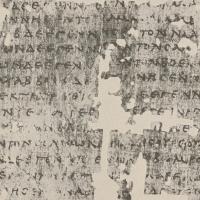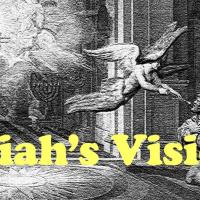Beth Immanuel is a friendly and welcoming community. Click here to learn what to expect when you visit.

New Wine and Old Wineskins
The Parable of Luke 5:36-39 Re-examined
The Emperor's daughter said to Rabbi Yehoshua ben Chananiah: "What beautiful Torah in an ugly vessel." He replied, "Learn from the house of your father. In what is the wine stored?" "In jars of clay," she answered. "But all the common people store their wine in jars of clay! You use them too? You should keep your wine in jars of gold and silver!" She went and had the wine placed in vessels of gold and silver, and it turned sour. "Thus," said he to her, "It is the same with Torah!" She asked, "But are there not handsome people who are learned?" He replied, "If they were ugly they would be even more learned!" (Talmud Bavli Nedarim 50b)
The Tax Collector's Banquet
Imagine, if you will, a banquet at the house of Levi the tax collector. There is singing and drinking and eating and merriment, and in the midst of it reclines the Master and his disciples. On the periphery of the scene are the Pharisees and several disciples of Yochanan the Immerser.We should not assume that the two groups are mutually exclusive. They have been following Yeshua, learning from him and scrutinizing him. They would not deign to eat with the sinners and tax collectors that constitute Yeshua's friends and followers, but they are intrigued enough to stay close and observe.
As the meal progresses, the Pharisees began to ask Yeshua's disciples some questions such as, "How often do you fast?" The disciples are unable to answer with their mouths full, so they shrug and look at Yeshua. When these same critics turn to Yeshua, informing him that his disciples don't fast like the disciples of Yochanan and the disciples of the Pharisees, Yeshua disarms them with the double parable of the Old Coat and the New Wine.
No one tears a patch from a new garment and sews it on an old one. If he does, he will have torn the new garment, and the patch from the new will not match the old. And no one pours new wine into old wineskins. If he does, the new wine will burst the skins, the wine will run out and the wineskins will be ruined. No, new wine must be poured into new wineskins. And no one after drinking old wine wants the new, for he says, 'The old is better.' (Luke 5:36-39)
It seems that the Master's profound observations concerning old wineskins, torn coats and new patches leave them speechless. They don't ask him any more questions, but perhaps that was only because, like the rest of us, they have no idea what Yeshua was talking about.
Incompatibility
Expositors have been scratching chins and nodding heads for a long time over the double parable of Luke 5:36-39. [Also Matt 9:14-17, Mark 2:18-22] The meaning of the parable is seemingly obvious. The new garment is the Gospel/Grace/Kingdom/Church and the old garment is the Old Covenant/Law/Judaism. No one tears a new garment to patch an old one. Grace and law do not mix.
Similarly, the new wine is the Gospel/Grace/Kingdom/Church and the old wineskin is the Old Covenant/Law/Judaism. Just as the new wine would burst the old skins and be spilled, so too the New Covenant Gospel of the Church Kingdom would be wasted if it was poured into the Old Covenant, Mosaic, legalistic religion of Judaism.
In almost unanimous consent interpreters and commentators have agreed that the old wine, old wineskins and the old coat are all symbols of Judaism and Law whereas the new wine and the new coat are symbols of Christianity and Grace. [Bruce, 1983; Lachs 1987; Lange; Lenski 1961; Meyer; Stein, 1992; Synge.] The unanimity of this interpretation of Yeshua's words has been so normative to Christian thinking that the term "Old Wine" is figuratively used to refer to Judaism in Christian writings.
As Kee aptly observes (1970), this "traditional interpretation of the double parable can be summed up in one word: incompatibility. It is supposed to teach that the Old and the New are incompatible, that Judaism is incompatible with Christianity." The old is worn and obsolete. The Church must be a new and separate movement, not a patch attempting to prolong the institutions of the Old Covenant. The New Covenant has erased and replaced the Old. This meaning of the double parable seems obvious. Or perhaps not.
Serious Problems
There are serious problems with the incompatibility interpretation. For example, it is anachronistic. Critical scholarship now acknowledges that Yeshua was not trying to start a new religion nor was his intention to dismantle Judaism. At the time that Yeshua gave the double parable there was no Christianity, no Church, no new religion for Judaism to be incompatible with. At the time the Gospel writers were recording the double parable, the Church Fathers' model of Yeshua as an antagonist of the Old Covenant and Judaism had not yet even been conceived.
What has, in fact, become worn and obsolete is the very notion that the historical Yeshua was opposed to the Torah and Judaism. Regarding this incompatibility interpretation Kee says, "There is no denying that Jesus radically transformed [and] revolutionized Judaism for his followers, but surely we need not labor the point that it was in fact Judaism which he transformed for them...To attribute the idea of incompatibility to Jesus, as a way of describing his relationship to Judaism, is bad theology and bad history."
His point is well taken. The incompatibility interpretation stems from a supersessionist theology of a later century. To place it into the mouth of Yeshua is absurd.
Kee (1970) is not alone in his observation of the difficulty with the incompatibility interpretation. He is joined by Nolland (1989), Mead (1988), Stern (1992). Kee also notes that the double parable has nothing to do with fasting. His own explanation, however, is less than satisfying and it necessitates a cut and paste that completely removes the parable the narrative context the gospels place it in.
Another serious problem with the incompatibility interpretation is the closing line of Luke 5:39, "And no one, after drinking old wine wishes for new; for he says, 'The old is good.'"[Or "the old is better."] This troublesome verse is found only in Luke's version of the double parable, and even then the Western version of the text omits it. It creates a serious problem for the incompatibility interpretation because it seems to reverse the value assigned to the new wine. If the Gospel is represented by the new wine, then the statement and even the entire metaphor is ridiculous in Yeshua's mouth. It is "as if Yeshua was comparing Judaism to good claret and the Gospel to cheap plonk." [Mead, 1988]
Marcion the Heretic was quick to deem the end of 5:39 as a Jewish interpolation into the Gospels.[Flusser, 1979] No surprise then that the Western text completely omits Luke 5:39. The omission belies an anti-Judaic bias in the scribal transmission. By removing the statement that the Old is good (or even "better"), the editor felt that he had removed "any suggestion that the Jews would reject the teachings of Christianity because they were well satisfied with Judaism."[Rice, 1980] If Rice is correct, then the double parable was being read according to the incompatibility interpretation at a very early stage.
Attempts to Salvage
Recognizing that the incompatibility interpretation is flawed, several scholars have made valiant attempts to reinterpret the double parable in a manner consistent with the rest of the Gospels. R. S. Good (1983) and David Flusser (1979), for example both try to force an explanation of the words "the old is better" by reversing the direction of the entire double parable in Luke. According to Good, Luke intentionally reinterpreted the two parables to mean that the Old is better because it is the Old Israel that Yeshua has come to save.
Flusser however contends that Luke preserves the original form. He is followed by Young (1995). The New Wine, bursting the skins and tearing the garment, should then be read as the Pharisees and the Sadducees. The old skins must be preserved: the old garment must be patched because they represent old Israel. This attractive and highly innovative explanation accounts for 5:39 and gets past the anachronistic problems of the traditional interpretations, but it forces itself against statements like 5:38 and does not fit the context. Even Good points out that it is not in concert with Matthew and Mark's versions.
Stern tries to reconcile the parables by going in several directions. He suggests that Yeshua meant for us to patch up Judaism by pre-shrinking the cloth of Messianic faith to fit the old coat of Judaism. Then he suggests that the new wineskins are actually the old wineskins, which have been reconditioned in order to receive the new wine. Hence the "new wineskins" should be read as renewed wineskins. While his interpretations are creative, they continue to operate under the premise of incompatibility and stretch the reader beyond the point of believability. In addition, they certainly don't give answers to the question of Luke 5:39 or to the context in which the parables are given.
Choosing the Twelve
The context in which the double parable occurs is a narrative relating how Yeshua chose his disciples. All of chapter five and the first 16 verses of chapter six string together several stories which deal with the calling and selection of the disciples. Luke 5:1-11 records the story of the first miraculous catch of fish during which Yeshua invites James, John, Peter (and by inference Andrew) to become his disciples. The pericope concludes in Luke 5:11 with the fishermen leaving their boats, their nets and the miraculous catch to follow Yeshua. The narrative then turns aside to relate two short healing stories (Luke 5:17-26), but returns to the calling of the disciples with the call of Levi in Luke 5:27 and 28. Like the fishermen, Levi leaves everything and follows Yeshua.
Levi holds a banquet for Yeshua and at this banquet the Pharisees level criticisms aimed at Yeshua's disciples. They asked his disciples, "Why do you eat and drink with tax collectors and 'sinners'?" They asked Yeshua, "Why don't your disciples fast and pray like Yochanan's disciples and like our disciples?" Both questions are criticisms of Yeshua's disciples and his choice of company.
Yeshua replies to the question on fasting with the bridegroom statements of Luke 5:34, 35 and then tells the double parable. Following the double parable, Luke six begins with a short pericope that at first seems unrelated to the concerns of choosing disciples. In the story (Luke 6:1-5) the Pharisees challenged Yeshua on Sabbath issues, but it is in fact the disciples' behavior that the Pharisees criticized, not the behavior of Yeshua. They accused the disciples of breaking the Sabbath by picking the heads of grain and husking them in their hands. Again the criticism is directed toward Yeshua's choice of disciples.
Connected with the Sabbath observance conflict raised in Luke 6:1-5, Luke offers a matching pericope in Luke 6:6-11 that echoes and complements the first but is clearly meant as an aside. Returning to the matter at hand, that is the call and selection of Yeshua's disciples, Luke closes the section with the final elimination round in which Yeshua chooses the Twelve (Luke 6:12-16). With the choosing of the Twelve, the disciple issue is settled.
| A. | Calling of the first disciples | 5:1-11 |
| (Aside to healing of the leper) | 5:12-16 | |
| (Aside to healing of the paralytic) | 5:17-26 | |
| B. | Calling of Levi | 5:27-28 |
| C. | Levi's banquet/Pharisee's criticisms of disciples Yeshua's response and double parable |
5:29-39 |
| D. | Pharisees accuse disciples of Sabbath violation | 6:1-5 |
| (Aside to a similar Sabbath story) | 6:6-11 | |
| E. | Final selection of the Twelve Disciples | 6:12-16 |
Smudged Paper and Old Wine
We might imagine the Pharisees leaving Levi's banquet and later pondering Yeshua's words saying, "I don't know what he meant by that, but it sounded very profound." Or perhaps not. Unlike us, the Pharisees probably knew exactly what Yeshua meant because they were probably already familiar with the symbolism Yeshua employed in his double parable. By comparing Luke 5:36-39 with the well known Pharisaic proverb of Avot 4.20, a whole new interpretation arises which is a natural complement to the context of the passage and is more satisfactory than those previously suggested.
| Luke 5:36-39 | Pirkei Avot 4:20 |
|---|---|
| He told them this parable: "No one tears a patch from a new garment and sews it on an old one. If he does, he will have torn the new garment, and the patch from the new will not match the old. And no one pours new wine into old wineskins. If he does, the new wine will burst the skins, the wine will run out and the wineskins will be ruined. No, new wine must be poured into new wineskins.And no one after drinking old wine wants the new, for he says, 'The old is better.'" | Elisha ben Avuyah said: "He who studies as a child, unto what can he be compared? He can be compared to ink written upon a fresh [new] sheet of paper. But he who studies as an adult, unto what can he be compared? He can be compared to ink written on a smudged [previously used and erased] sheet of paper. Rabbi Yose ben Yehudah of the city of Babylon said, "He who learns from the young, unto what can he be compared? He can be compared to one who eats unripe grapes, and drinks unfermented wine from his vat. But he who learns from the old, unto what can he be compared? He can be compared to one who eats ripe grapes, and drinks old wine. Rabbi (Meir) said: Do not pay attention to the container but pay attention to that which is in it. There is a new container full of old wine, and here is an old container which does not even contain new wine. |
Like the larger Gospel context of Luke chapters five and six, the Avot passage is comparing different types of teachers, disciples and teachings. If we allow the similes of Avot 4 to inform the metaphors of Luke 5, we have surprising results.
It could certainly be argued that the two sages quoted are Tannaim from a century after the time of Yeshua, but the metaphors and analogies which these Tannaim employed and which constitute the proverbs of Pirkei Avot belonged to a body of oral tradition, much of which predates the day of Yeshua. For example, see the passage from Nedarim 50b quoted at the beginning of the article that uses the same symbolic values for wine and containers.
In Avot, the vessels for containing wine are not institutions, religious movements or teachings. The vessels containing the wine are individuals. The wine is the teaching that the individual consumes or contains.
Flusser (1979) cites other related Rabbinical and Talmudic passages in which wine is symbolic for Torah and the interpretation of scripture Applying this symbolism to Luke, we could parse out Luke 5:36-39 as follows:
| Symbol | Meaning |
|---|---|
| New garment | previously uneducated students |
| Old garment | previously educated students |
| Patch | teaching |
| New wineskins | previously uneducated students |
| Old wineskins | previously educated students |
| New wine | new teaching |
| Old wine | previous teaching |
Singular Meaning: New teaching requires previously uneducated students in order to be received.
No one takes a lesson meant for a new student and tries to teach it to an old (already educated) student. If he does, he will fail to teach the new student, and the lesson meant for the new student will be rejected by the old student.
No one teaches new Torah-teaching to old (previously educated) students. If he does, the new teaching will be rejected, the student will be lost. No. Instead new Torah-teaching must be taught to new students. And no one after receiving old teaching (previous education) wants the new, for he says, "The old teaching is better."
The Avot interpretation of the double parable offers several advantages. Unlike the incompatibility theory, the Avot interpretation is not anachronistic. It does not pit Yeshua against Judaism nor does it imagine a conflict between New Covenant Grace and Old Covenant Law. Instead, it pits Yeshua's choice of disciples against the Pharisees' choice of disciples. Unlike the incompatibility theory, the Avot interpretation fits the context in which the parable is found, namely the call and selection of Yeshua's disciples. It addresses the Pharisee's criticism about fasting and it answers the problems raised by Luke 5:39.
Unsmudged Paper
Luke has gone to some pains to demonstrate the unsavory character of Yeshua's choice in disciples. They are fishermen, tax collectors and "sinners." They are feasting and drinking instead of fasting and praying. They are bungling Sabbath observance to feed their stomachs. They are not the pious types. They are not the types to follow in the tradition of the disciples of Hillel and Shammai. They have not been educated with the sages. In this regard, they are like a clean slate, a fresh, unsmudged piece of paper for Yeshua to write on.
This is not to suggest that the disciples had no education. A primary education in Yeshua's day involved an extensive memorization of Scripture and knowledge of Torah. Educational standards in the Galilee may have even surpassed those of Judah, so even fishermen and tax collectors had received training in the Scriptures. However, only the very gifted went on to study beyond the age of 12 or 13 and only the truly exceptional (and perhaps wealthy) went on to become disciples of the sages.[Bivin, 1988]
The situation with the disciples reminds me of a celebrated metal welder who was known in northeast Minnesota for his excellent work. He often remarked that he would rather teach welding to a drunk he found in a bar who had never held a welding torch in his hand than hire a welder with previous training and experience. A man who had never been taught to weld was still teachable, but a man who already knew how to weld was not.
This was the case with Yeshua's choice of disciples. The Pharisees, up to this point in the Gospel narrative, were not yet opponents of Yeshua but were probably still contemplating whether or not to become his disciples. They could not understand Yeshua's choice of disciples and must have been baffled that he had not yet approached them with the position. At Levi's banquet, they criticized the uncouth character and behavior of Yeshua's choice in disciples. Yeshua responded with the double parable, which in essence explained to the Pharisees why they were not qualified for the job of disciple and why the low-life, which he chose to associate with, were.
The double parable is not a polemic against Judaism; it is simply an explanation of his choice of disciples. In essence, Yeshua was saying to the Pharisees, "Look, You can't teach an old dog new tricks." We can now understand how the double parable answers to the question about fasting. They said, "Yochanan's disciples often fast and pray, and so do the disciples of the Pharisees (which is to say, so do we), but yours go on eating and drinking." Yeshua's statements about the bridegroom answered directly to the issue of fasting, but the double parable answered to the broader criticism being raised. That criticism was that Yeshua's disciples were not at all like the disciples of Yochanan or the Pharisees.
The Old is Better
Finally, the Avot interpretation solves the problems raised by Luke 5:39, "And no one, after drinking old wine wishes for new; for he says, 'The old is good.'" If the parable is comparing Yeshua's Torah teaching (New Wine) with the Pharisee's Torah teaching (Old Wine) the meaning becomes perfectly clear. Disciples who have already studied Torah under the Pharisaic schools (or under the tutelage of Yochanan) and have learned to interpret according to those traditions and models are unlikely to be interested in a new approach. Those students will be apt to disregard contradictory teaching because they have already formed opinions and made judgments. They will regard the education they have already received as superior.
Yeshua has chosen fishermen and tax collectors precisely because of their lack of formal education. Luke returns to the disciples' lack of formal education in Acts chapter 4 when the Sanhedrin questions Peter and John. In Acts 4:13 Luke writes, "Now as [the Sanhedrin] observed the confidence of Peter and Yochanan and understood that they were uneducated and untrained men, they were amazed, and began to recognize them as having been with Yeshua." On that day, when two, poorly educated fishermen stood before the Sanhedrin, they demonstrated the full caliber of their education under Yeshua and vindicated his choice of disciples. New garments, new wineskins and new students.
Bibliography:
Rice, George E. 1980. Some Further Examples of Anti-Judaic Bias in the Western Text of the Gospel of Luke. Andrews University Seminary Studies 18 (2): 149-156
Kee, Alistair. 1970. The Old Coat and the New Wine, A Parable of Repentance. Novum Testementum
Good, R.S. 1983. Yeshua, Protagonist of the Old, In Luke 5:33-39. Novum Testamentum 25(1): 19-36
Synge, F. C. The Parable of the Patch. Expository Times 56: 26-27
Lachs, Samuel Tobias. 1987. A Rabbinic Commentary on the New Testament. Ktav Publishing House, Inc. Hoboken, New Jersey
Mead, A. H. 1988. Old and New Wine. St. Luke 5:39. Expository Times. 99(8): 234-235.
Nolland, John. 1989. Word Biblical Commentary Volume 35A. Word Books, Dallas, Texas.
Flusser, David. 1979. Do You Prefer New Wine? Immanuel 9: 26-31.
Meyer, Heinrich August Wilhelm. Critical and Exegetical Handbook to the Gospels of Mark and Luke. Volume 2.
T. & T. Clark, Edinburgh. Lange, John Peter. Commentary on the Holy Scriptures. Critical, Doctrinal and Homiletical. Zondervan Publishing House, Grand Rapids, MI.
Lenski, R.C.H. 1961. The Interpretation of Luke's Gospel. Augsburg Publishing House, Minneapolis, MN.
Stern, Robert H. 1992. The New American Commentary, Volume 24 Luke. Broadman Press, Nashville, TN.
Young, Brad H. 1995. Jesus the Jewish Theologian. Hendrickson Publishers, Peabody, MA.
Bruce, F.F. 1983. Hard Sayings of Yeshua. IV Press. Downers Grove, Illinois.
Stern, David H. 1992. Jewish New Testament Commentary. JNT Publications, Inc. Maryland
Bivin, David. 1988. Jesus' Education. Jerusalem Perspective 14,15




